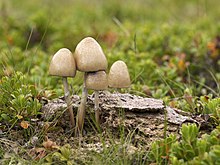
Back Анелярыя паўяйцападобная Byelorussian Anel·lària Catalan Panaeolus semiovatus CEB Brithdegyll wyffurf Welsh Panaeolus semiovatus Spanish Harilik sitaseen Estonian Orribeltz arraultzerdi Basque Kauluskirjoheltta Finnish Prstenasti smetištar Croatian Gyűrűs trágyagomba Hungarian
| Panaeolus semiovatus var. semiovatus | |
|---|---|

| |
| Scientific classification | |
| Kingdom: | |
| Division: | |
| Class: | |
| Order: | |
| Family: | |
| Genus: | |
| Species: | |
| Variety: | P. semiovatus var. semiovatus
|
| Trinomial name | |
| Panaeolus semiovatus var. semiovatus Fr. (Lundell)
| |
| Synonyms | |
| |
| Panaeolus semiovatus var. semiovatus | |
|---|---|
| Gills on hymenium | |
| Cap is convex | |
| Hymenium is adnexed | |
| Stipe has a ring | |
| Spore print is black | |
| Ecology is saprotrophic | |
| Edibility is inedible | |
Panaeolus semiovatus var. semiovatus, also known as Panaeolus semiovatus and Anellaria separata, and commonly known as the shiny mottlegill, ringed panaeolus, common fungus of the feces variety,[1] or egghead mottlegill, is a medium-sized buff-colored mushroom that grows on horse dung, and has black spores. Though nonpoisonous,[2] it is generally regarded as inedible and possessing a rather abysmal taste,[3] and a few people experience gastric upset after consumption.
- ^ Arora, David (1986). Mushrooms demystified: a comprehensive guide to the fleshy fungi (Second ed.). Berkeley: Ten Speed Press. ISBN 978-0-89815-169-5.
- ^ Miller Jr., Orson K.; Miller, Hope H. (2006). North American Mushrooms: A Field Guide to Edible and Inedible Fungi. Guilford, CN: FalconGuide. p. 234. ISBN 978-0-7627-3109-1.
- ^ Phillips, Roger (2010). Mushrooms and Other Fungi of North America. Buffalo, NY: Firefly Books. p. 236. ISBN 978-1-55407-651-2.